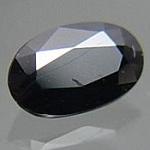|
ClassicGems.net |
|
|
 |
|
Aeschynite-(Y) |
|
|
Discovered in 1966; IMA status: Valid (IMA approved 1966) |
|||
|
|
|
Chemistry |
|
|
|
|
|
(Y,Ca,Fe)(Ti,Nb)2(O,OH)6 |
|
|
|
Yttrium Calcium Iron Titanium Niobium Oxide Hydroxide |
|
Molecular Weight: |
274.97 gm |
|
Composition: |
Calcium |
4.37 % |
Ca |
6.12 % |
CaO |
|
|
Yttrium |
19.40 % |
Y |
24.64 % |
Y2O3 |
|
|
Titanium |
30.47 % |
Ti |
50.84 % |
TiO2 |
|
|
Niobium |
8.45 % |
Nb |
12.08 % |
Nb2O5 |
|
|
Iron |
2.03 % |
Fe |
2.61 % |
FeO |
|
|
Hydrogen |
0.37 % |
H |
3.28 % |
H2O |
|
|
Oxygen |
34.91 % |
O |
|
|
|
|
|
100.00 % |
|
100.00 % |
= TOTAL OXIDE |
|
|
|
||||
|
Classification |
|
|
|
|
|
Oxides |
|
|
4/D.21-20 |
|
|
|
4 : OXIDES (Hydroxides, V[5,6] vanadates, arsenites, antimonites, bismuthites, sulfites, selenites, tellurites, iodates)
|
|
Related to: |
Aeschynite Group. The yttrium analogue of Aeschynite-(Ce). Forms two series, with Aeschynite-(Ce) and with Tantalaeschynite-(Y). |
|
Varieties: |
Alumolyndochite, Calciolyndochite |
|
Synonyms: |
Aeschinite-(Y), Aeschynite-(Yt), Blomstrandine, Blomstrandinite, Eschynite, Priorite, Taiyite |
|
|
|
|
Crystal Data |
|
|
|
|
|
Crystals, to 10 cm, commonly tabular, less commonly prismatic, also granular. |
|
|
None |
|
|
|
|
|
Physical Properties |
|
|
|
|
|
Perfect on {100}, {010} and {001} |
|
|
Irregular/Uneven |
|
|
Brittle |
|
|
5.0 - 6.0 |
|
|
4.82 - 4.93 (g/cm3) |
|
|
None |
|
|
Not Radioactive |
|
|
Other: |
Magnetic |
|
|
|
|
Optical Properties |
|
|
|
|
|
Black, Brownish black, Brown, Brownish Yellow, pale Yellow, Yellow-Orange, pale Greenish Yellow |
|
|
Opaque to Semi-Transparent |
|
|
Resinous, Waxy, Pearly, Sub-Metallic, Submetallic to Pearly on crystal faces, Resinous to Waxy on fracture surfaces. |
|
|
2.19 - 2.50 Biaxial ( + ) |
|
|
0.150 - 0.220 |
|
|
Strong; r > v |
|
|
None |
|
|
|
|
|
Occurances |
|
|
|
|
|
Geological Setting: |
In granite and granite pegmatites; in ankerite-dolomitic carbonatites; as a detrital mineral in placers. |
|
Common Associations: |
Euxenite, Monazite, Xenotime, Allanite, Zircon, Fergusonite, Thorite, Synchysite, Gadolinite, Chernovite, Columbite, Biotite, Muscovite, Titanite, Corundum |
|
Common Impurities: |
REE, Sn |
|
Type Locality: |
Urstad feldspar quarry, Hidra (Hitterø), Flekkefjord, Vest-Agder, Norway |
|
Year Discovered: |
1966 |
|
View mineral photos: |
|
|
|
|
|
More Information |
|
|
|
|
|
|
|
|
|
|
|
Aeschynite-(Y) is a rare ytrrium REE (rare earth element) mineral that is extremely rare as a gemstone. It is found at several locations around the world but the main source is the type locality; Iveland, Aust-Agder, Norway. It is closely related to Aeschynite-Ce (Cerium) and Aeschynite-Nd (Neodymium), both of which are slightly radioactive. Aeschynite-(Y) gets its name from the Greek word for shame, in allusion to the fact that early chemists had difficulty with separations of titanium from zirconium in some samples and (Y) for its yttrium content as the dominant rare-earth element. Rare earth oxides such as Aeschynite form from elements that are often leftover from other minerals. Other rare earth oxides such as Fergusonite-(Ce), Samarskite-(Y) and Euxenite-(Y) have very similar properties to Aeschynite and are often associated with each other and are difficult to distinguish from each other. Even the common oxide, Rutile, is almost indistinguishable from these rare earth oxides without chemical tests when Rutile is found in its massive form. Aeschynite-(Y) is found at a number of localities around the world including many localities in Norway, including: at Urstad, on Hidra (Hitterö) Island; Sätersdalen; at Kåbuland, Mölland, and Birkeland; near Arendal, Mörefjär, and Salterö; at Frikstad. In Russia, at Miass, in the Ilmen Mountains, Southern Ural Mountains. In Switzerland, from Piz Lucendro, near the St. Gotthard Pass, on Pizzo Rotondo, Val Bedretto, and Val Nalps, Tavetsch, Graub¨unden; and elsewhere. In Italy, on Pizzo Cervandone, Alpe Devero, Val d’Aosta, Piedmont. At Böckstein, near Bad Gestein, Austria. From Tongafeno, Ambedabao, Ambohitromby, near Ambatofotsy, Tomboarivo, and other localities in Madagascar. From the Embabaan district, Swaziland. In the USA at Clora May Mine (Mina Blanca; Clara May Lode), Trout Creek Pass pegmatite District, Buena Vista, Chaffee Co., Colorado. A number of other less-well-defined localities are known. |
|
|
Aeschynite-(Y) gems for sale:
|
|||||||||||||||||||||||||||

